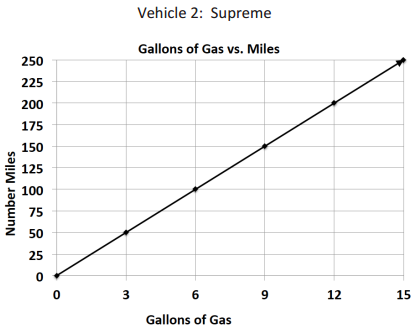Engage NY Eureka Math 6th Grade Module 1 Lesson 19 Answer Key
Eureka Math Grade 6 Module 1 Lesson 19 Example Answer Key
Example 1.
The ratio of cups of blue paint to cups of red paint is 1: 2, which means for every cup of blue paint, there are two cups of red paint. In this case, the equation would be red = 2 × blue, or r = 2b, where b represents the amount of blue paint and r represents the amount of red paint. Make a table of values.
Answer:

Example 2.
Ms. Siple is a librarian who really enjoys reading. She can read \(\frac{3}{4}\) of a book in one day. This relationship can be represented by the equation days = \(\frac{3}{4}\) books, which can be written as d = \(\frac{3}{4}\)b where b represents the number of books and d represents the number of days.
Answer:

Eureka Math Grade 6 Module 1 Lesson 19 Exercise Answer Key
Exercise 1.
Bryan and ShaNiece are both training for a bike race and want to compare who rides his or her bike at a faster rate. Both bikers use apps on their phones to record the time and distance of their bike rides. Bryan’s app keeps track of his route on a table, and ShaNiece’s app presents the information on a graph. The information is shown below.

a. At what rate does each biker travel? Explain how you arrived at your answer.
Answer:

Bryan travels at a rate of 25 miles per hour. The double number line had to be split in 3 equal sections.
That’s how l got25; (25 + 25 + 25) = 75.
ShaNiece travels at 15 miles per hour. I know this by looking at the point (1, 15) on the graph.
The 1 represents the number of hours, and the 15 represents the number of miles.
b. ShaNiece wants to win the bike race. Make a new graph to show the speed ShaNiece would have to ride her bike in order to beat Bryan.
Answer:

The graph shows ShaNiece traveling at a rate of 30 miles per hour, which is faster than Bryan’s rate.
Exercise 2.
Braylen and Tyce both work at a department store and are paid by the hour. The manager told the boys they both earn the same amount of money per hour, but Braylen and Tyce did not agree. They each kept track of how much money they earned in order to determine if the manager was correct. Their data is shown below.
Braylen: m = 10.50h where h represents the number of hours worked and m represents the amount of money Braylen was paid.
Tyce:

a. How much did each person earn in one hour?
Answer:

Tyce earned $11.50 per hour. Braylen earned $10.50 per hour.
b. Was the manager correct? Why or why not?
Answer:
The manager was not correct because Tyce earned $1 more than Braylen in one hour.
Exercise 3.
Claire and Kate are entering a cup stacking contest. Both girls have the same strategy: stack the cups at a constant rate so that they do not slow down at the end of the race. While practicing, they keep track of their progress, which is shown below.
Claire:

Kate: c = 4t, where t represents the amount of time in seconds and c represents the number of stacked cups.
a. At what rate does each girl stack her cups during the practice sessions?
Answer:
Claire stacks cups at a rate of 5 cups per second. Kate stacks cups at a rate of 4 cups per second.
b. Kate notices that she is not stacking her cups fast enough. What would Kate’s equation look like if she wanted to stack cups faster than Claire?
Answer:
Answers will vary. c = 6t, where t represents the time in seconds, and c represents the number of cups stacked.
Eureka Math Grade 6 Module 1 Lesson 19 Problem Set Answer Key
Victor was having a hard time deciding which new vehicle he should buy. He decided to make the final decision based on the gas efficiency of each car. A car that is more gas efficient gets more miles per gallon of gas. When he asked the manager at each car dealership for the gas mileage data, he received two different representations, which are shown below.


Question 1.
If Victor based his decision only on gas efficiency, which car should he buy? Provide support for your answer.
Answer:
Victor should buy the Legend because it gets 18 miles per gallon of gas, and the Supreme only gets 16\(\frac{2}{3}\) miles per gallon. Therefore, the Legend is more gas efficient.
Question 2.
After comparing the Legend and the Supreme, Victor saw an advertisement for a third vehicle, the Lunar. The manager said that the Lunar can travel about 289 miles on a tank of gas. If the gas tank can hold 17 gallons of gas, is the Lunar Victor’s best option? Why or why not?
Answer:
The Lunar is not a better option than the Legend because the Lunar only gets 17 miles per gallon, and the Legend gets 18 miles per gallon. Therefore, the Legend is still the best option.
Eureka Math Grade 6 Module 1 Lesson 19 Exit Ticket Answer Key
Kiara, Giovanni, and Ebony are triplets and always argue over who can answer basic math facts the fastest. After completing a few different math fact activities, Kiara, Giovanni, and Ebony record their data, which is shown below.
Kiara: m = St, where t represents the time in seconds, and m represents the number of math facts completed.


Question 1.
What is the math fact completion rate for each student?
Answer:
Kiara: 5 math facts/second
Giovanni: 4 math facts/second
Ebony: 6 math facts/second
Question 2.
Who would win the argument? How do you know?
Answer:
Ebony would win the argument because when comparing the unit rates of the three triplets, Ebony completes math facts at the fastest rate.